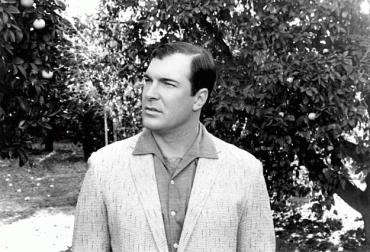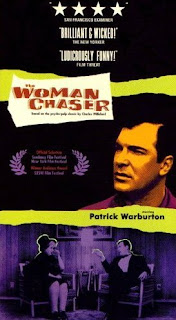 The television show "Seinfeld" was not only a comedy phenomenom in its own right, it also provided a wonderful springboard/showcase for the many actors who made guest appearances on it - both people already fairly well-known at the time (Courteney Cox, Jon Lovitz, Janeane Garafalo and Teri Hatcher) and those then-unknown (Wendy Malik, Veanne Cox and Jon Favreau).
The television show "Seinfeld" was not only a comedy phenomenom in its own right, it also provided a wonderful springboard/showcase for the many actors who made guest appearances on it - both people already fairly well-known at the time (Courteney Cox, Jon Lovitz, Janeane Garafalo and Teri Hatcher) and those then-unknown (Wendy Malik, Veanne Cox and Jon Favreau).Arguably, the most vivid impression was made by a newcomer named Patrick Warburton, who played the recurring role of Puddy, Elaine's burly, affable, sort-of-vague boyfriend. Big and handsome, Warburton played dimness to the hilt, and his deadpan delivery of his character's signature line, "Yeah, that's right," was funny no matter how many times he said it.
It was only a matter of time, I thought, before Warburton would make the leap onto the big screen - which is where he belongs.
And that's what happened. Well, kind of.,,
"The Woman Chaser," an amiably minor entertainment from 1999, marked the actor's first full-fledged starring role in a movie after getting his feet wet with a supporting part in Wes Craven's "Scream 3."
Frankly, "The Woman Chaser" isn't all that much of a movie.
It's every inch a "first film" - a movie by and about someone clearly obsessed with movies. Filmmaker Robinson Devor has fashioned what feels like an autobiographical tale about Richard Hudson (Warburton), a well-heeled Los Angeles layabout who, out of boredom, gets the idea of making his own movie. He's lived in a company town all his life, after all - except for a recent brief stint in San Francisco - so it makes sense that he would be bitten by the filmmaking bug.
The fact that Richard had never shown any interest in movies or moviemaking before or that he isn't even sure he has the talent or the resources to do it is beside the point. The urge is in the L.A. air, and like bad air, this urge is cloudy and inescapable and feels a bit recycled.
So is the film surrounding Richard Hudson - a tale that every would-be or neophyte filmmaker eventually tackles. To his credit, Devor has had the good sense to set "The Woman Chaser" in the past, a place where Hollywood always has - and always will - exist. He's filtered a very personal story through some thick L.A.-in-the-'50s ambience.
Shot in a very authentic-looking black-and-white from 40 or 50 years ago, "The Woman Chaser" fairly drips in the sunny/seedy atmosphere of Hollywood - or Hollyweird or Tinseltown or whatever you want to call it. It's this ambience and Warburton's performance that beef up the slender storyline, which is based on a piece of choice pulp by Charles Willeford, whose writings inspired two other eclectic films - Monte Hellman's
"Cockfighter" (1974) and George Armitage's "Miami Blues" (1990).
The plot picks up Richard just after he's returned from his stint in San Francisco and has moved back in with his socialite mother (Lynette Bennett), who is remarried to a washed-up Hollywood producer (Paul
Malevich) who, in turn, has a grown daughter (Marilyn Rising) who, in turn, is still a virgin and wants Richard to sexually initiate her.
He obliges her - with some boredom - and also beds a few other women, but for the most part, the film's title is highly deceptive. Richard doesn't so much chase women as fall, almost accidentally, into bed with them. He really has no prowess to speak of, no real technique.
Buying a used-car lot, Richard displays his sense of showmanship - and drive - when he forces his salesmen to dress up in Santa Claus costumes in the middle of August. From there, it is only one small step to his idea of making a movie, called "The Man Who Got Away," about a trucker who mows down a little girl and then has to fend off the police. Richard leans on his stepfather for advice and expertise and then makes his movie.

And that's about it. That's "The Woman Chaser." In the span of a few short months, Richard turns into Orson Welles, becoming increasingly unstable as he shoots film and more film; discovers players who can't act; browbeats one of his leading ladies, using sex to get a decent performance out of her, and then battles with his film editor (Max Kerstein) and studio brass (Ernie Vincent). He saves his film in the editing room - but only by whittling it down to 63 minutes, which makes it virtually unreleasable as a feature.
Everyone suggests selling it to television, but that's out of the question for this auteur.
Devor, who has an excellent eye for everything '50s and an even better one for faces, basically strings together a series of oddball vignettes dominated by those faces. One of the best bits in the film - which has almost nothing to do with anything - is a sequence in which a shirtless Richard joins his mother in her dance studio for a pas de deux that's made compelling by both its incestuous overtones and the fact that the giant Warburton is so light on his feet. It's too bad he wasn't around in the '50s because some mogul, like Jack Warner, for example, would have loved him - and grabbed him up and groomed him for stardom.
Warburton even looks like an actor from the 1950s, not at all sculpted and smooth the way other contemporary actors are.
Anyway, this film which should have made him a Star, didn't. He was born too late. Patrick Warburton was made for the 1950s.
"The Woman Chaser," which is not available on DVD (although it was on VHS briefly), plays San Francisco's invaluable Roxie Theater, 3117 16th Street (at Valencia), starting tomorrow (25 February), playing for a week (through 3 March). If you're in the area, see it.
No comments:
Post a Comment